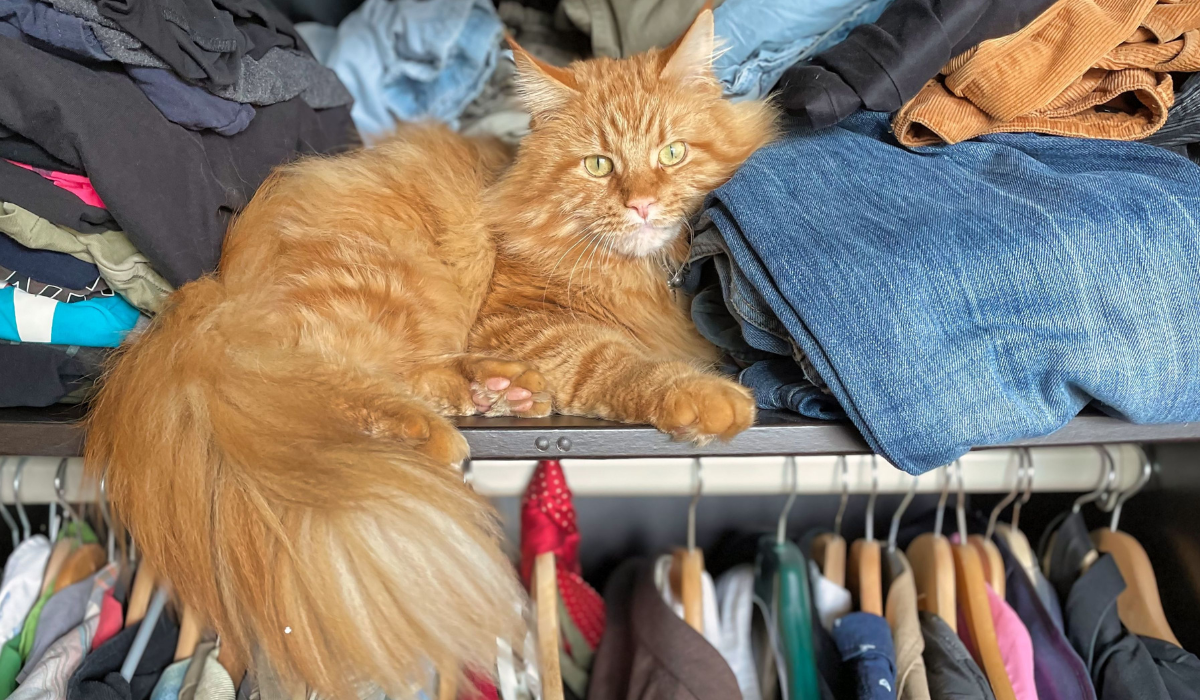Why does my Cat Sleep on my Clothes

Cats are adorable pets that are known for their unique and mysterious behaviors. One of the common behaviors that cat owners may observe is their cats sleeping on their clothes. While this behavior may seem strange to some cat owners, it is actually a common phenomenon among cats. In this article, we will explore the reasons why cats sleep on clothes and what it means for you and your feline friend.
Understanding Feline Behavior
To understand why cats sleep on clothes, we need to first understand their behavior. Cats are territorial animals and have a strong instinct to mark their territory. They use their sense of smell to identify and mark their territory. They also have a strong desire for comfort and security.
The Comfort Factor
Cats love to sleep in warm, comfortable places, and your clothes could provide the perfect spot. The fabric of your clothes is soft and warm, which can provide your cat with the comfort they desire. Additionally, your clothes may have your scent on them, which can be soothing and reassuring for your feline friend.
Your Scent
Cats have a strong sense of smell and can recognize their owner’s scent. When a cat sleeps on your clothes, they are surrounded by your scent, which can provide them with a sense of comfort and security. Your scent may also remind them of the times you spent together, which can bring back pleasant memories for your cat.
Territorial Behavior
Cats are territorial animals and have a strong desire to mark their territory. They may mark their territory by rubbing their scent on objects or by sleeping on them. By sleeping on your clothes, your cat is marking their territory and claiming ownership over the item.
Seeking Attention
Cats are social animals and love attention from their owners. They may sleep on your clothes as a way to seek attention from you. By sleeping on your clothes, they are in a location where you are likely to notice them and give them attention.
Stress and Anxiety
Cats may sleep on your clothes if they are feeling stressed or anxious. The familiar scent of your clothes can provide them with a sense of comfort and security, which can help to alleviate their stress and anxiety.
Medical Issues
Sometimes, cats may sleep on your clothes as a way to signal that they are not feeling well. If your cat suddenly starts sleeping on your clothes and is displaying other unusual behavior, it may be a sign of an underlying medical issue. It is important to take your cat to the veterinarian to rule out any medical problems.
Aging
As cats age, they may become less active and prefer to sleep more. Sleeping on your clothes may be a sign that your cat is feeling less energetic and needs a comfortable spot to rest.
Preventing Unwanted Behavior
If you find that your cat is sleeping on your clothes and you do not want them to do so, there are a few things you can do to prevent this behavior. One option is to provide your cat with a comfortable bed in a location where they feel safe and secure. Another
Common Sleeping Behaviors of Cats
Cats are known for their love of sleep, and they can sleep for up to 16 hours a day. It is not uncommon for cats to sleep in various positions, such as curled up in a ball or stretched out on their back. Some cats also prefer to sleep in enclosed spaces, such as boxes or under furniture. Understanding your cat’s sleeping behavior can help you provide a comfortable and safe environment for them.
- Curled Up Position
One of the most common sleeping positions for cats is curled up in a ball. This position allows cats to conserve body heat and protect their vital organs. Cats may also tuck their head under their paws or tail in this position for added warmth and security.
- Stretched Out Position
Another common sleeping position for cats is stretched out on their side or back. This position allows cats to fully relax their muscles and get a good stretch. Some cats may even stretch out with their legs behind them like a frog.
- Enclosed Spaces
Cats are known for their love of enclosed spaces, and this includes sleeping areas. Enclosed spaces provide cats with a sense of security and privacy. You may notice your cat sleeping in boxes, on shelves, or under furniture.
- Cat Hammocks
Cat hammocks are becoming increasingly popular as a comfortable and cozy sleeping spot for cats. They provide a comfortable and elevated sleeping spot that can be easily mounted on a wall or window. Many cats love the feeling of being suspended in the air and can sleep for hours in a cat hammock.
- Designated Sleeping Spots
While cats may sleep in a variety of positions and locations, it is important to provide them with a designated sleeping spot. This can be a cat bed, a cat tree, or a cozy spot on a piece of furniture. Providing your cat with a designated sleeping spot can help them feel more secure and comfortable in their surroundings.
Conclusion
In conclusion, cats have a variety of sleeping behaviors, including curled up, stretched out, and in enclosed spaces. Understanding your cat’s sleeping behavior can help you provide a comfortable and safe environment for them. It is important to provide your cat with a designated sleeping spot to help them feel secure and comfortable in their surroundings. If you have any concerns about your cat’s sleeping behavior, consult with a veterinarian.
RECENT ARTICLES
